Crafting effective marketing emails is a skill honed through a blend of psychology, creativity, and data-driven strategies. In the digital age, where inboxes are flooded with countless messages, standing out requires more than just compelling content—it demands strategic planning and execution. This comprehensive guide will walk you through the essential steps and advanced techniques for writing marketing emails that resonate with your audience and drive meaningful action. Additionally, we’ll explore how leveraging tools like Prism Reach can elevate your email marketing efforts through deep personalization and AI-powered insights.
Key Facts
- Personalization increases email open rates by up to 50% and click-through rates by 14%.
- Mobile-optimized emails are crucial, with 46% of all emails opened on mobile devices.
- A/B testing can improve conversion rates by 49% when done consistently.
- Emails with a single call-to-action (CTA) can increase clicks by 371% and sales by 1617%.
- Segmentation can boost open rates by 14.31% and click-through rates by 100.95%.
Upgrade Your Email Marketing with AI Personalization!
Essential Steps to Craft Persuasive Marketing Emails
Crafting Compelling Subject Lines
The subject line is your first impression—it can make or break your email campaign. To create attention-grabbing subject lines, consider incorporating techniques such as urgency, curiosity, or personalization.
- Urgency: “Last chance: Your exclusive offer expires tonight!”
- Curiosity: “Discover the secret to doubling your productivity.”
- Personalization: “[Name], here’s the solution you’ve been looking for.”
Keep your subject lines short (around 40 characters) and avoid spam trigger words. Occasionally, incorporating relevant emojis can help your email stand out in crowded inboxes, but use them sparingly.
Personalizing Your Content
Personalization goes beyond addressing the recipient by name. Leveraging data insights to tailor content based on past behavior, preferences, and demographics can significantly enhance engagement.
- Use dynamic content blocks that change based on the recipient’s profile.
- Segment your email list to ensure content relevance.
- Reference past interactions, such as previous purchases or website visits.
Tools like Prism Reach can automate and enhance this personalization by creating detailed user avatars and predicting subscriber interests, ensuring each email feels uniquely crafted for the individual.
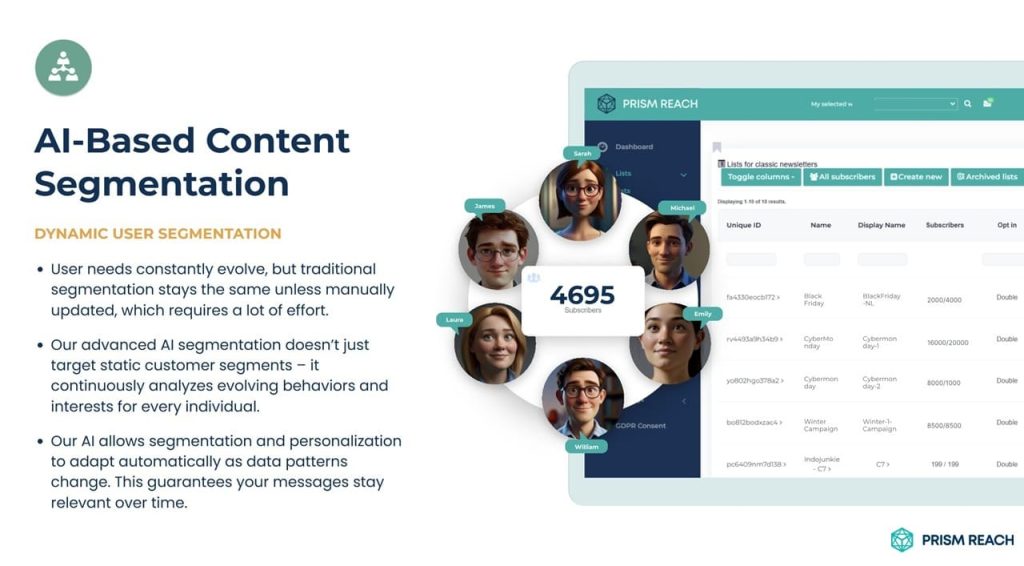
Structuring Your Email for Readability
An effectively structured email ensures that your key messages are delivered even if the entire email isn’t read. Implementing the “Inverted Pyramid” structure can help achieve this:
- Top: Most important information and key messages.
- Middle: Supporting details and additional context.
- Bottom: Additional information or supplementary content.
Additionally, using the “One-Sentence Paragraph” technique can create visual breaks, improve readability, and emphasize key points.
Incorporating Effective Calls-to-Action (CTA)
A clear and compelling CTA is essential for driving the desired action. Instead of asking for a significant commitment, use the “Micro-Commitment” strategy by requesting small, easy-to-do tasks that can lead to larger commitments later.
- Example: “Take our 10-second survey” instead of “Buy now.”
- Use action-oriented language like “Shop Now” or “Get Your Free Trial.”
- Ensure the CTA button stands out visually with contrasting colors and ample white space.
Repeating the CTA towards the end of the email and using directional cues can further increase click rates. Prism Reach’s AI-powered personalization can help tailor CTAs to each subscriber’s behavior and preferences, enhancing their effectiveness.
Optimizing for Mobile Devices
With nearly half of all emails opened on mobile devices, ensuring your emails are mobile-optimized is non-negotiable. A responsive design that adapts to different screen sizes will provide a seamless reading experience.
- Use a single-column layout for easier navigation.
- Ensure text is legible without zooming.
- Make buttons and links easily tappable.
Tools like Prism Reach can automatically optimize email layouts for mobile devices, ensuring your content looks great on any screen.
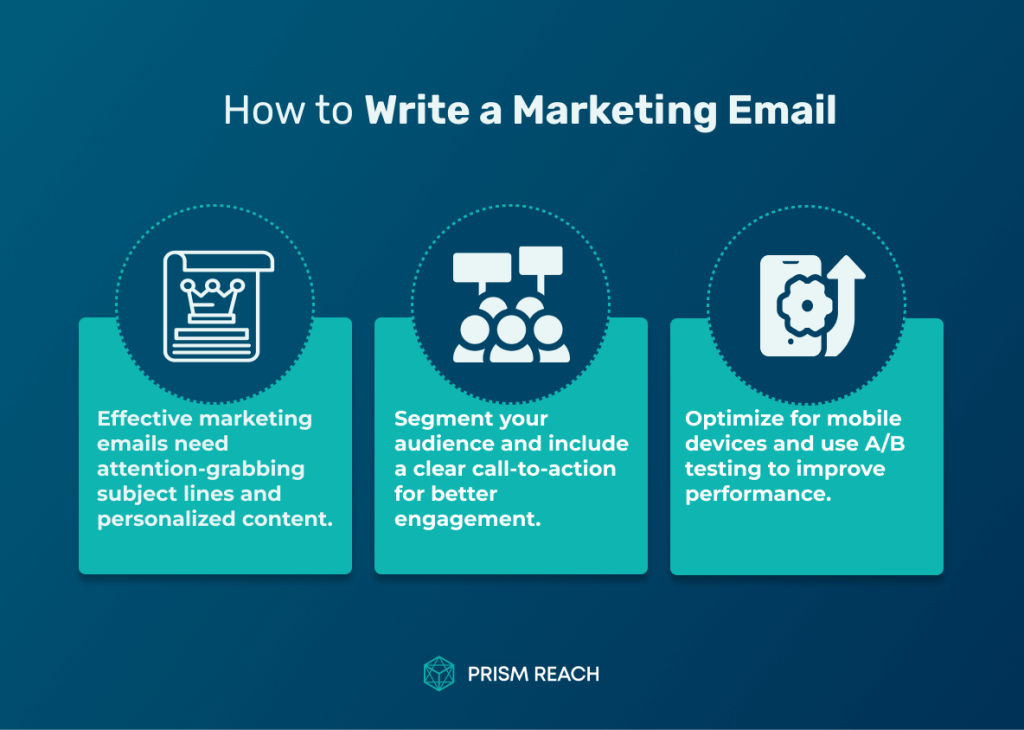
Advanced Techniques for Email Marketing Success
Behavioral Targeting
Behavioral targeting involves tracking how subscribers interact with your website and previous emails to create highly targeted campaigns that address their specific interests and needs.
For example, if a subscriber frequently visits a particular product category on your website, you can tailor your email content to feature similar products or related offers.
Predictive Personalization
Utilizing AI and machine learning algorithms, predictive personalization anticipates what content or products a subscriber is most likely to be interested in next. This makes your emails feel almost prescient in their relevance, significantly boosting engagement and conversions.
Prism Reach excels in predictive personalization by analyzing vast amounts of data to forecast subscriber preferences, allowing you to deliver content that aligns perfectly with their anticipated needs.
Interactive Emails
Incorporating interactive elements like polls, quizzes, or image carousels within your emails can create a more engaging experience. Interactive emails encourage subscribers to interact with your content directly within the email, increasing time spent and engagement levels.
For instance, an accordion menu can allow subscribers to expand sections for more information without leaving the email, enhancing user experience and engagement.
Using Storytelling in Your Marketing Emails
Storytelling transforms your emails from mere promotional messages into engaging narratives that resonate with your audience. By weaving product features or promotional offers into a compelling story, you can capture the reader’s attention and foster a deeper connection.
For example, starting an email with a customer success story can highlight how your product solves real-world problems, making your offer more relatable and enticing.
Automation in Email Marketing
Automation streamlines your email marketing efforts, allowing you to create sophisticated, personalized email journeys that would be impossible to manage manually. From welcome series and abandoned cart reminders to post-purchase follow-ups and re-engagement campaigns, automation ensures timely and relevant communication with your subscribers.
Prism Reach’s automation features enable you to set up triggers based on specific subscriber actions, ensuring that each email is sent at the optimal time and with content tailored to the recipient’s behavior and preferences.
Improving Email Deliverability
Ensuring your emails reach the subscriber’s inbox is crucial for the success of your campaigns. To improve deliverability, focus on the following areas:
- List Hygiene: Regularly clean your email list to remove inactive subscribers and invalid email addresses.
- Authentication: Implement SPF, DKIM, and DMARC protocols to verify your emails are coming from a legitimate source.
- Engagement-Based Sending: Prioritize sending to subscribers who regularly open and interact with your emails.
- Content Quality: Ensure your emails provide value and aren’t overly promotional to avoid being flagged as spam.
Monitoring your sender reputation and using tools like Sender Score or GlockApps can help identify and address deliverability issues promptly.
Growing Your Email List
Building a high-quality email list is fundamental to successful email marketing. Here are some effective strategies to grow your list:
- Content Upgrades: Offer exclusive, high-value content in exchange for email sign-ups.
- Exit-Intent Popups: Capture visitors who are about to leave your site with a compelling offer.
- Social Media Integration: Use social platforms to promote email sign-ups and exclusive content.
- Referral Programs: Encourage current subscribers to refer friends in exchange for incentives.
- Lead Magnets: Create valuable resources like ebooks, webinars, or tools that require an email to access.
Remember, the quality of your subscribers is more important than quantity. Focus on attracting individuals who are genuinely interested in your brand and likely to engage with your emails. Prism Reach can assist by targeting and attracting high-quality subscribers through its advanced AI-driven personalization and segmentation capabilities.
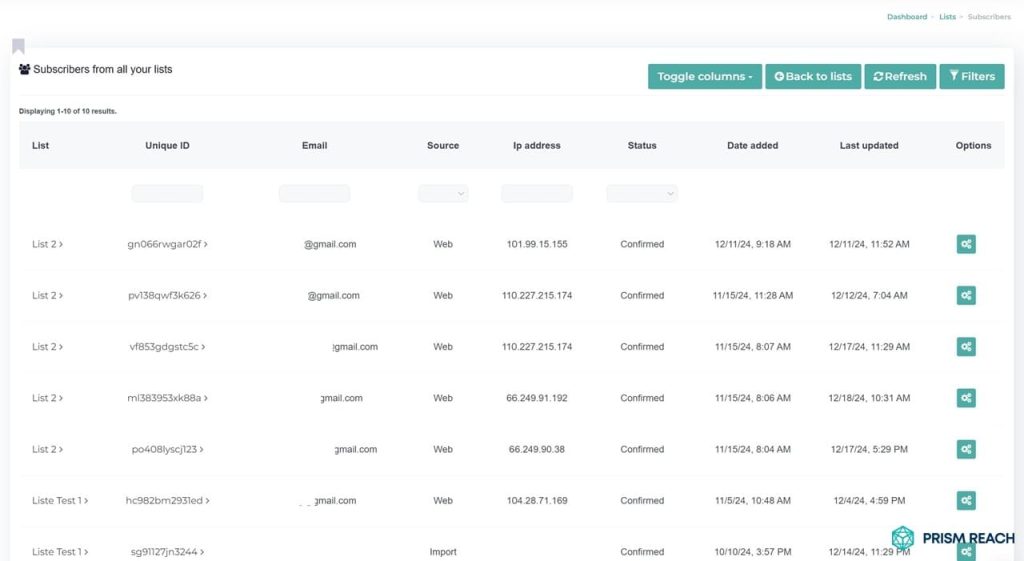
Common Mistakes to Avoid in Marketing Emails
Avoiding common pitfalls can save your campaigns from underperformance and protect your sender reputation. Here are some mistakes to steer clear of:
- Overusing Promotional Language: Excessive promotion can turn off subscribers. Aim for a balanced mix of valuable content and promotional offers.
- Neglecting Mobile Optimization: With a significant portion of emails opened on mobile devices, failing to optimize for mobile can result in poor user experience.
- Sending Emails Without a Clear Purpose: Each email should have a specific goal, whether it’s driving sales, sharing news, or engaging subscribers.
- Using Deceptive Subject Lines: Misleading subject lines can damage trust and lead to higher unsubscribe rates.
- Failing to Segment Your Email List: Sending irrelevant content to your audience can decrease engagement and increase unsubscribe rates.
- Ignoring Preheader Text: The preheader text is prime real estate for enticing opens. Make sure to use it effectively to complement your subject line.
- Not Testing Across Multiple Platforms: Ensure your emails render correctly across various email clients and devices to maintain a consistent experience.
Measuring the Success of Your Marketing Emails
To gauge the effectiveness of your marketing emails, focus on tracking key metrics that provide insights into your campaign’s performance.
- Open Rates: Indicate how compelling your subject lines are.
- Click-Through Rates (CTR): Show how engaging your content and CTAs are.
- Conversion Rates: Measure the email’s impact on your business goals.
- Unsubscribe Rates: Help you understand if your content is resonating or causing fatigue.
- Bounce Rates: Indicate the quality of your email list.
- Revenue per Email: Understand the direct financial impact of your campaigns.
- Forward/Share Rates: Gauge how viral your content is.
- List Growth Rate: Monitor the growth of your subscriber base over time.
Advanced tools like Google Analytics and dedicated email marketing platforms can provide deeper insights, allowing you to refine your strategies continually. Prism Reach offers comprehensive analytics and reporting features that help you track these metrics effortlessly, providing actionable insights to optimize your campaigns.
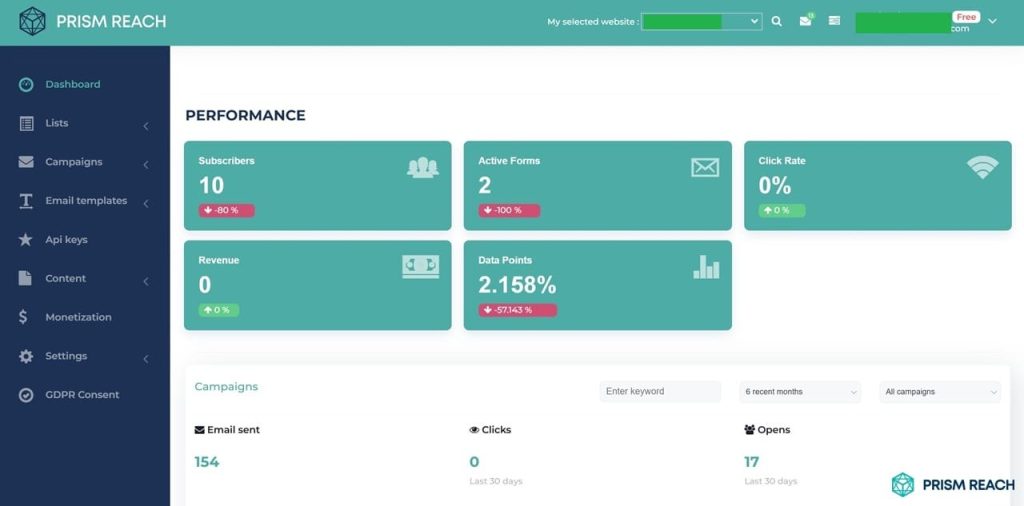
Prism Reach: Enhancing Your Email Marketing Strategy
Prism Reach is an innovative AI-powered SaaS solution designed to transform your email marketing campaigns through deep personalization. By leveraging sophisticated AI algorithms, Prism Reach customizes every aspect of your newsletters based on subscriber behavior and preferences, ensuring highly targeted and effective communication.
Key Benefits of Prism Reach
- Increased Engagement: Personalized content tailored to individual subscriber interests leads to up to 40% higher engagement rates.
- Higher Revenue: Tailored advertising and efficient content targeting result in higher monetization rates for your newsletters.
- Improved Productivity: Automation and AI-driven insights reduce the time required to create and manage campaigns, allowing you to focus on strategy and creativity.
How Prism Reach Works
Prism Reach’s core functionality revolves around its proprietary AI technology, which clusters website content and social media posts into relevant categories. This AI uses various data points to create detailed user avatars, enabling personalized newsletter content that incorporates factors such as location, engagement history, and predicted interests.
Seamless Setup and Integration
Setting up Prism Reach is quick and user-friendly, allowing you to integrate the platform within minutes. Features include one-click uploads for easy migration of existing subscriber lists and AI-enhanced sign-up forms designed to increase sign-up rates and improve GDPR compliance.
Dynamic Content Selection
The AI-driven dynamic content selection ensures that each subscriber receives the most relevant content based on their unique profile, enhancing the personalization of every newsletter.
Advanced AI Features
Prism Reach includes anti-spam checks and focuses on high deliverability, maintaining engagement levels and avoiding spam filters. Its predictive analytics determine the best times to send newsletters, maximizing subscriber engagement.
Future Prospects
Prism Reach aims to expand its technology into the eCommerce sector and explore new AI-driven marketing applications. Continuous improvement of its AI algorithms ensures that Prism Reach remains at the forefront of email marketing innovation.
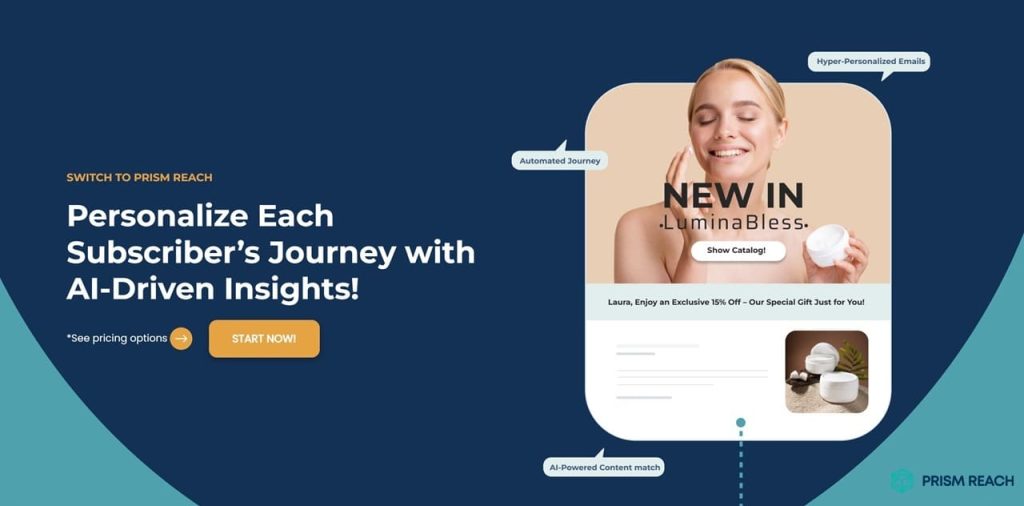
Benefits of Using Prism Reach in Your Email Marketing
- Hyper-Personalization: Deliver content that feels uniquely crafted for each subscriber, fostering deeper connections and higher engagement.
- Automated Campaign Creation: Save time and resources with automated workflows that handle campaign creation and delivery based on subscriber behavior.
- Comprehensive Analytics: Gain valuable insights into subscriber behavior and campaign performance, enabling continuous optimization and improved ROI.
Implementing Prism Reach: A User Journey
The typical user journey with Prism Reach involves a streamlined process where subscribers sign up through a customized form, select their interests, and receive personalized newsletters that cater specifically to their preferences. This journey not only enhances user satisfaction but also boosts the likelihood of long-term subscriber retention.
FAQ
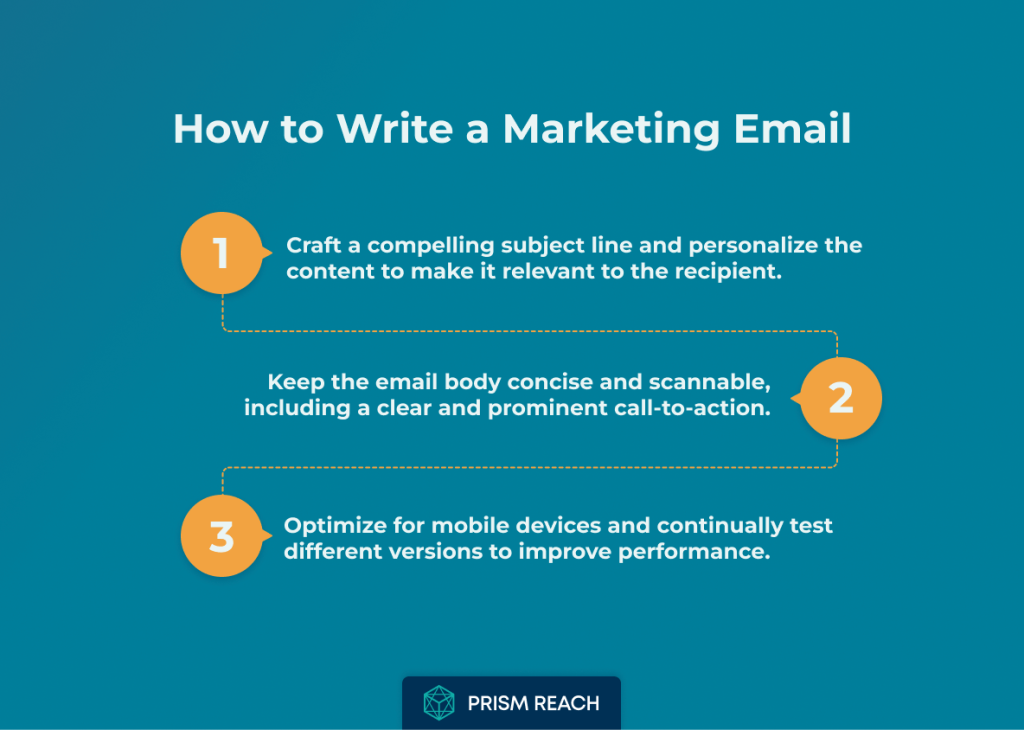
Conclusion
Mastering the art of writing marketing emails is an ongoing process of refinement and adaptation. By implementing the strategies and best practices outlined in this guide, you can significantly enhance the effectiveness of your email campaigns. From crafting compelling subject lines to leveraging personalization techniques, each element plays a crucial role in creating emails that engage, convert, and drive business results.
To truly excel in email marketing and achieve unprecedented levels of personalization and engagement, consider leveraging the power of Prism Reach. Our AI-powered SaaS solution is designed to provide highly personalized newsletters for publishers, blogs, forums, and eCommerce businesses. Prism Reach creates a unique email marketing experience tailored to individual subscriber interests, leading to higher engagement and increased revenue.
With Prism Reach, you can benefit from features such as hyper-personalization, AI-driven user avatars, and automated campaign creation and delivery. The platform imports all website content and social media posts, organizing them into relevant categories using proprietary AI models. This allows for the creation of personalized emails that incorporate elements such as location, historical engagement data, predicted engagement data, and past interests.
Experience the future of email marketing and take your campaigns to the next level with Prism Reach. By leveraging our advanced AI technology and personalization capabilities, you can create newsletters that treat each subscriber as an individual, not just a number. This approach fosters real engagement and nurtures long-lasting relationships with your audience, ultimately driving better results for your email marketing efforts.
Interesting sources
- https://digitalmarketinginstitute.com/blog/how-to-write-a-marketing-email
- https://www.demandcurve.com/blog/how-to-write-a-marketing-email